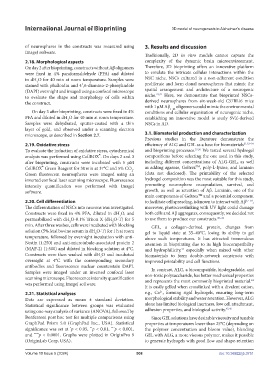Page 516 - IJB-10-5
P. 516
International Journal of Bioprinting 3D model of neurogenesis in Alzheimer’s disease
of neurospheres in the constructs was measured using 3. Results and discussion
ImageJ software.
Traditionally, 2D in vitro models cannot capture the
2.18. Morphological aspects complexity of the dynamic brain microenvironment.
On day 2 after bioprinting, constructs without Aβ oligomers Therefore, 3D bioprinting offers an innovative platform
were fixed in 4% paraformaldehyde (PFA) and diluted to emulate the intricate cellular interactions within the
in dH O for 40 min at room temperature. Samples were NSC niche. NSCs cultured in a non-adherent condition
2
stained with phalloidin and 4′,6-diamino-2-phenylindole proliferate and form clonal neurospheres that mimic the
(DAPI) overnight and imaged using a confocal microscope spatial arrangement and architecture of a neurogenic
to evaluate the shape and morphology of cells within niche. 22,31 Here, we demonstrate that bioprinted NSCs-
the construct. derived neurospheres from six-week-old C57BL/6 mice
with 1 µM Aβ oligomers could mimic the environmental
1–42
On day 3 after bioprinting, constructs were fixed in 4% conditions and cellular organization of neurogenic niche,
PFA and diluted in dH O for 40 min at room temperature. establishing an innovative model to study SVZ-derived
2
Samples were dehydrated, sputter-coated with a thin NSCs in AD.
layer of gold, and observed under a scanning electron
microscope, as described in Section 2.7. 3.1. Biomaterial production and characterization
Previous studies in the literature demonstrate the
2.19. Oxidative stress efficiency of ALG and GEL as a base for biomaterials 21,32–34
To evaluate the induction of oxidative stress, cytochemical and bioprinting processes. 35,36 We tested several hydrogel
analysis was performed using CellROX ® . On days 2 and 3 compositions before selecting the one used in this study,
after bioprinting, constructs were incubated with 5 μM including different concentrations of ALG-GEL, as well
TM
CellROX ® Green Reagent for 30 min at 37°C and 5% CO . as adding agarose, Geltrex , poly-L-lysine, and laminin
2
Green fluorescent neurospheres were imaged using an (data not disclosed). The printability of the selected
inverted confocal laser scanning microscope. Fluorescence hydrogel composition was the most suitable for this study,
intensity quantification was performed with ImageJ promoting neurosphere encapsulation, survival, and
software. growth, as well as retention of Aβ. Laminin, one of the
main components of Geltrex and a potential component
TM
2.20. Cell differentiation to facilitate cell spreading, is known to interact with Aβ 37–39 ,
The differentiation of NSCs into neurons was investigated. moreover, photocrosslinking with UV light could damage
Constructs were fixed in 4% PFA, diluted in dH O, and both cells and Aβ aggregates, consequently, we decided not
2
permeabilized with dH O-0.1% Triton X (dH O-T) for 5 to use them to produce our constructs. 40–42
2
2
min. After three washes, cells were incubated with blocking GEL, a collagen-derived protein, changes from
solution (5% fetal bovine serum in dH O-T) for 1 h at room gel to liquid state at 35–40°C, losing its ability to gel
2
temperature, followed by overnight incubation with anti- above such temperatures. It has attracted tremendous
Nestin (1:250) and anti-microtubule-associated protein 2 attention in bioprinting due to its high biocompatibility
(MAP-2) (1:500) and diluted in blocking solution at 4°C. and hydrophilicity, especially when mixed with other
43
Constructs were then washed with dH O and incubated biomaterials to form double-network constructs with
2
overnight at 4°C with the corresponding secondary improved printability and cell functions.
antibodies and fluorescence nuclear counterstain DAPI.
In contrast, ALG, a biocompatible, biodegradable, and
Samples were imaged under an inverted confocal laser non-toxic polysaccharide, has better mechanical properties
scanning microscope. Fluorescence intensity quantification 44
was performed using ImageJ software. and represents the most commonly bioprinted material.
It is easily gelled when crosslinked with a divalent cation,
2+
2.21. Statistical analyses e.g., Ca , forming rigid hydrogels, ensuring long-term
Data are expressed as mean ± standard deviation. morphological stability and water retention. However, ALG
Statistical significance between groups was evaluated alone has limited biological inertness, low cell attachment,
using one-way analysis of variance (ANOVA), followed by adhesion properties, and biological activity. 45,46
Bonferroni post hoc test for multiple comparisons using Since GEL solutions have desirable viscosity and tunable
GraphPad Prism 5.0 (GraphPad Inc., USA). Statistical properties at temperatures lower than 25°C (depending on
**
*
***
significance was set at p < 0.05, p < 0.01, p < 0.001, the polymer concentration and bloom value), blending
and **** p < 0.0001. Graphs were plotted in OriginPro 9 GEL with ALG, a more viscous polymer, makes it possible
(OriginLab Corp, USA). to generate hydrogels with good flow and shape-retention
Volume 10 Issue 5 (2024) 508 doi: 10.36922/ijb.3751

